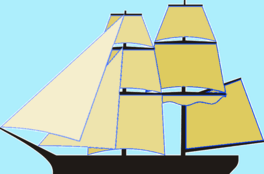HMS Manly (1804) facts for kids

Configuration of typical brig
|
|
Quick facts for kids History |
|
|---|---|
| Name | HMS Manly |
| Operator | Royal Navy |
| Ordered | 9 January 1804 |
| Builder | John Dudman & Co, Deptford Wharf |
| Laid down | February 1804 |
| Launched | 7 May 1804 |
| Commissioned | May 1804 |
| Captured | January 1806 |
| Name | unknown |
| Acquired | by capture January 1806 |
| Captured | 1 January 1809 |
| Name | HMS Manly |
| Operator | Royal Navy |
| Acquired | by capture 1 January 1809 |
| Captured | 2 September 1811 |
| Name | HDMS The Manly |
| Acquired | 2 September 1811 by capture |
| Fate | Captured March 1813 or sold October 1813 |
| Name | HMS Bold |
| Operator | Royal Navy |
| Acquired | March or November 1813 |
| Fate | Sold 11 August 1814 |
| General characteristics | |
| Class and type | Archer-class gun-brig |
| Tons burthen | 17779⁄94 (bm) |
| Length |
|
| Beam | 22 ft 6 in (6.86 m) |
| Depth of hold | 9 ft 5+1⁄2 in (2.883 m) |
| Sail plan | Brig |
| Complement | 50 |
| Armament |
|
HMS Manly was a small but mighty gun-brig (a type of warship) launched in 1804. She had a very eventful life! During her time at sea, she was captured by the Dutch, then taken back by the British. Later, the Danes captured her, and finally, the British got her back again. After her last recapture in 1813, she was renamed HMS Bold and was eventually sold in 1814.
Contents
Manly in Early British Service
HMS Manly began her service in May 1804. Her first captain was Lieutenant George Mackay. In 1805, she sailed near Boulogne, a port in France.
Manly also helped other British ships, like HMS Autumn, Biter, and Pincher, to get back a ship named George. George had been captured by a French privateer (a privately owned warship) but was retaken by the British in February 1805.
First Capture: By the Dutch
In January 1806, while under the command of Lieutenant Martin White, Manly ran aground (got stuck in shallow water) near the River Ems in East Friesland. When Lieutenant White went ashore to try and free the ship, a group of Dutchmen captured him.
The ship's master, William Golding, then decided to surrender Manly to Dutch gunboats. Because of this, Golding was later removed from his rank and ordered to serve as a regular sailor for two years. Lieutenant White also received a warning for not making the ship lighter before trying to pull it free.
The Dutch records show that their gunboat Vos found Manly stuck. After some fighting, the British crew left the ship, and the Dutch took control of Manly.
Dutch Service and Recapture
After being captured, Manly served the Batavian Republic (which was the Netherlands at the time). We don't have many details about her service during this period.
On 1 January 1809, the British ship Onyx, a 10-gun brig with 75 men, found and recaptured Manly from the Dutch. Manly and another Dutch brig had sailed from the Texel (a Dutch island) to try and stop British merchant ships.
The fight lasted about two and a half hours. The British had three wounded, one of whom sadly died later. Manly, which had 94 men, lost five men and had six wounded. She was under the command of Captain-Lieutenant J.W. Heneyman of the Dutch Navy.
This recapture was a big success for the British. Commander Charles Gill, the captain of Onyx, was promoted to post-captain (a higher rank). The crew members who survived this battle later received the Naval General Service Medal in 1847.
Manly Returns to British Service
After being recaptured, Manly was repaired and refitted between February and August 1809. She started service again in June under Lieutenant Thomas Greenwood.
In May 1810, boats from several British ships, including Manly, went into the Vlie (a channel in the Netherlands). They attacked and burned a French lugger (a type of small boat) and captured four other enemy vessels. The British had no injuries during this action.
Second Capture: By the Danes
On 17 August 1811, Manly sailed from Sheerness with a group of ships heading to the Baltic. She was under the command of Lieutenant Richard William Simmonds. On 2 September 1811, while sailing off Arendal on the Norwegian coast, Manly and another British ship, Chanticleer, met three Danish 18-gun-brigs.
The Danish ships first fought Chanticleer, which managed to escape. Then, they focused their attack on Manly. The Danes fired heavily, damaging Manly's masts and ropes. Surrounded, with only six guns left, and having lost one man killed and three wounded, Manly was forced to surrender. Lieutenant Simmonds was later cleared of any blame for the loss of his ship.
The Danish account explains that their ships Alsen, Lolland, and Samsø chased the two British ships. Lolland caught up with Manly and, after a battle, forced her to surrender. The Danes reported one man killed on Lolland but no other casualties.
Danish Service as The Manly
The Danes took Manly into their navy, keeping her name and her guns. She was commissioned under Captain Holm but was sold by the Danes on 28 October 1813.
Manly Becomes HMS Bold
The British recaptured Manly for the second time in 1813. When she returned to British service, she was renamed HMS Bold. This was done because a new Manly had just started service, and another ship named Bold had been lost recently.
Final Days
HMS Bold (the former Manly) was sold on 11 August 1814 for £940.

